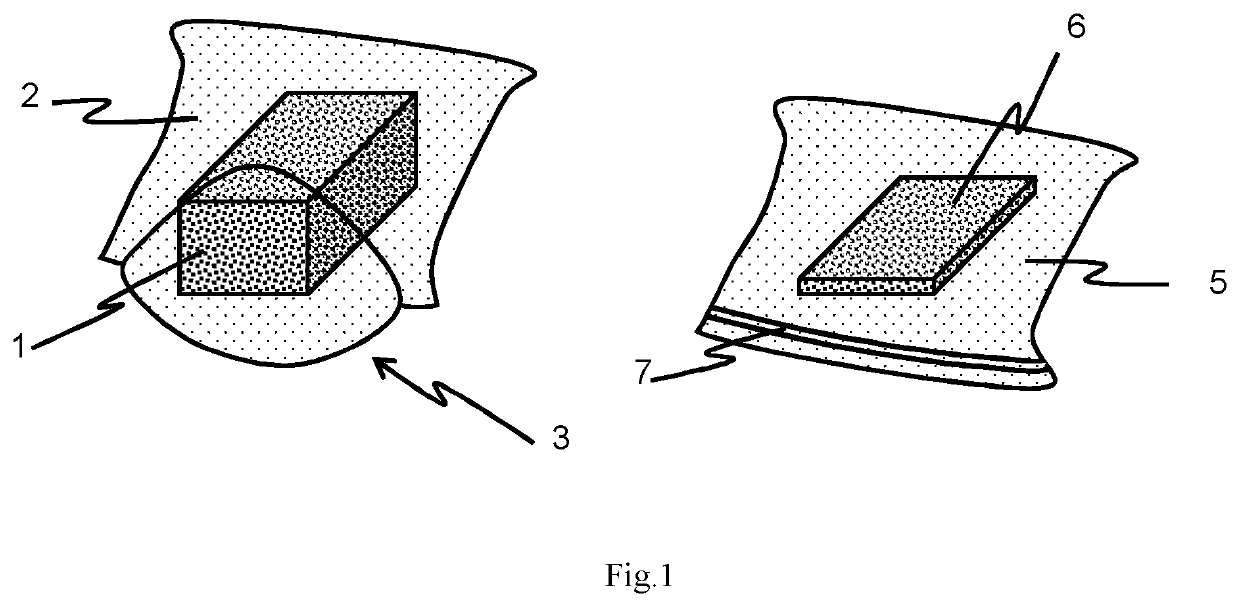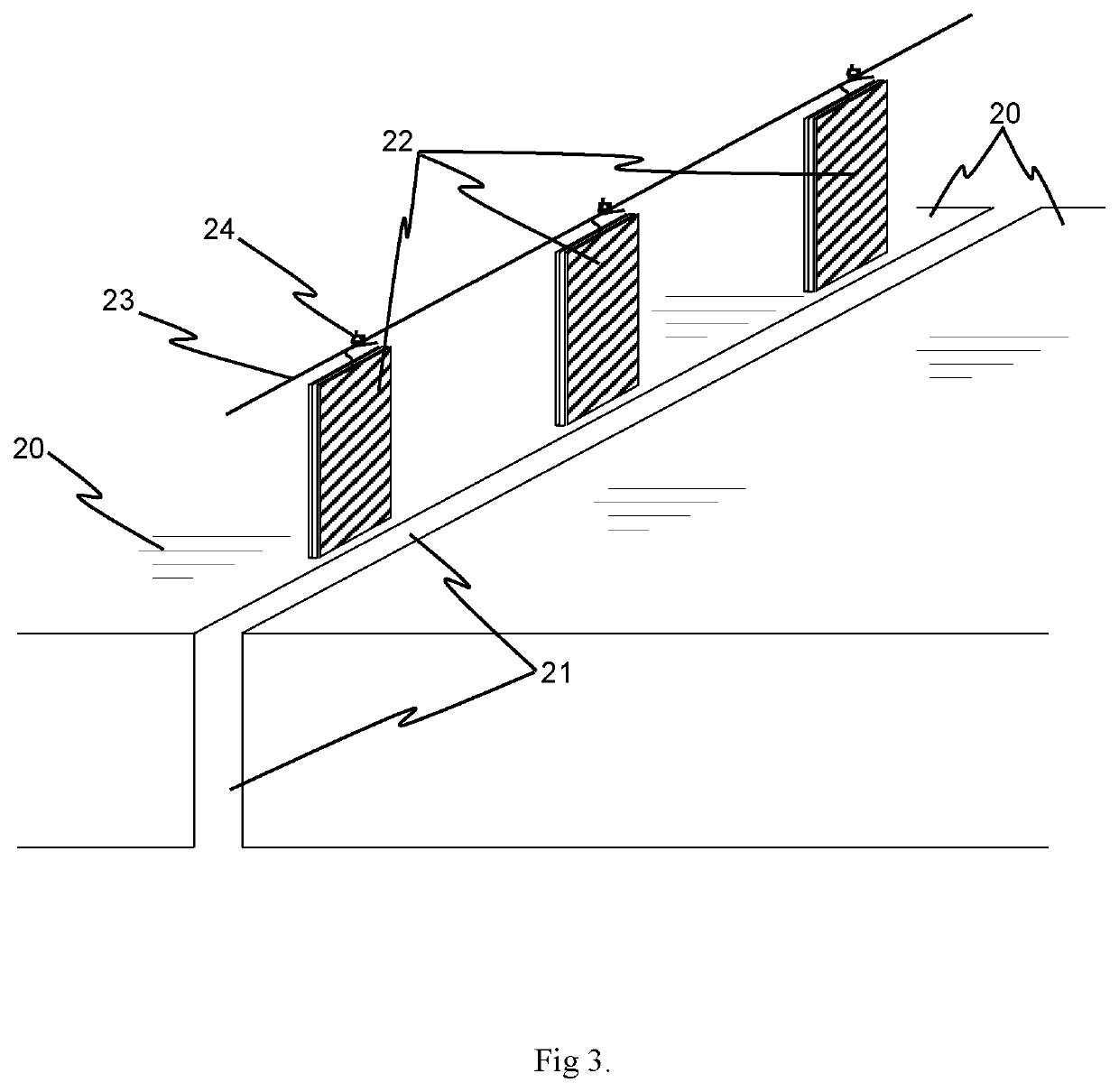Expandalbe anode assembly
an anode assembly and expandable technology, applied in the direction of paving details, protection foundations, constructions, etc., can solve the problems of steel reinforcement structure deterioration, steel reinforcement corrosion rate, concrete cracking, etc., to improve the electrolytic contact and connect quickly and efficiently
- Summary
- Abstract
- Description
- Claims
- Application Information
AI Technical Summary
Benefits of technology
Problems solved by technology
Method used
Image
Examples
example 1
[0056]The expanding component of the anode assembly was constructed using blocks of foam 1, a vacuum packing machine (not shown) and vacuum pouches 2. The foam block 1 was polyurethane upholstery foam with a density of about 50 kg / m3. The foam 1 was resilient as opposed to a memory foam and measured about 185×105×47 mm.
[0057]The pouch 2 measured 300×200 mm when stored flat and was made of a clear (see through) plastic. In particular, the pouch 2 is made from a polyamide air impenetrable exterior and a polyethylene interior. The vacuum pouches 2 and vacuum packing machine were obtained from “lava vacuum packing”, and were manufactured in Germany by Manfred Landig. The vacuum packing machine used was the LAVA V.100 Classic vacuum Sealer.
[0058]Each foam block 1 was placed inside the vacuum pouch 2 which in turn was placed on a flat surface next to the vacuum packing machine. An A4 sized book weighing about 1 kg was placed on top of the pouch 2 and foam 1 to keep the pouch 2 flat as air...
example 2
[0062]A single anode assembly 22 according to the present invention is best shown in FIG. 2. The assembly comprises a compressed foam 10, an evacuated vacuum pouch 11, a sheet of zinc 12 attached to an outer surface of the evacuated vacuum pouch 11, an adhesive (not shown), optionally a second sheet of zinc 13 and an electrical connector 14.
[0063]The compressed foam block 10 inside the sealed evacuated vacuum pouch 11 was prepared as described in Example 1. The foam block measured 185×105×47 mm before compression. The zinc plate 12, 13 was obtained from a zinc sheet supplier and was cut to a size of 105×185 mm. It was about 0.5 mm thick and weighed 130 grams.
[0064]The zinc plate, 12, 13 was prepared for use as an anode by soldering a copper core electric cable to the back of the plate 12, 13 and connecting it to a plastic coated titanium wire. The connection 14 was insulated with the exception of a short length of titanium that protruded just beyond the anode surface. This formed th...
example 3
[0066]FIG. 3 shows an array of anode assemblies 22 installed in a gap 21 between reinforced concrete elements 20. To install the anode assemblies 22, the gap 21 at the joint between the concrete elements is cleared of debris to prepare it to receive the anode assemblies 22. The assemblies 22 are then prepared for insertion into the gap 21. This may include removing any external packaging and / or applying a thin layer of bedding material over the surface of the anode 12, 13 of the assembly 22 to facilitate electrolytic contact with the surface of the reinforced concrete elements 20. In this embodiment the bedding material was lime putty.
[0067]The anode assemblies 22 are then inserted into the gap 21 and arranged so that the assembly connectors 24 are exposed at the edge of the gap 21. The evacuated pouches 11 of the anode assembly 22 are then punctured (the seal is broken) to allow the assembly to expand and press the anode(s) 12, 13 of the assembly 22 against the surface(s) of the re...
PUM
| Property | Measurement | Unit |
|---|---|---|
| density | aaaaa | aaaaa |
| thickness | aaaaa | aaaaa |
| density | aaaaa | aaaaa |
Abstract
Description
Claims
Application Information
 Login to View More
Login to View More - R&D
- Intellectual Property
- Life Sciences
- Materials
- Tech Scout
- Unparalleled Data Quality
- Higher Quality Content
- 60% Fewer Hallucinations
Browse by: Latest US Patents, China's latest patents, Technical Efficacy Thesaurus, Application Domain, Technology Topic, Popular Technical Reports.
© 2025 PatSnap. All rights reserved.Legal|Privacy policy|Modern Slavery Act Transparency Statement|Sitemap|About US| Contact US: help@patsnap.com



